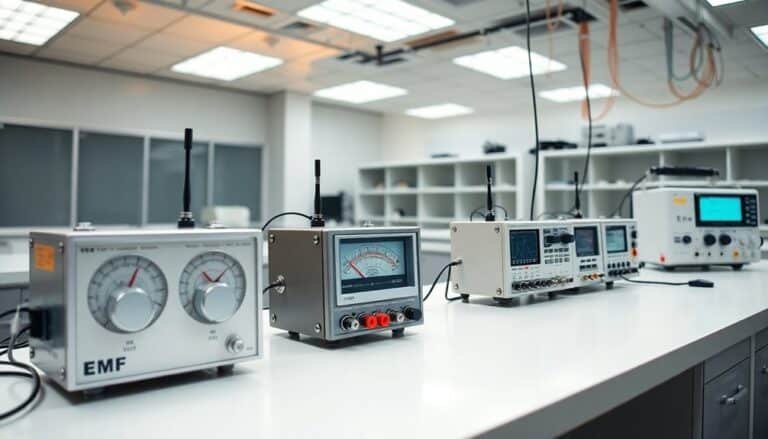How to Use Wi-Fi Safely at Home
To enhance Wi-Fi safety at home, use WPA2 or WPA3 encryption and create complex, regularly updated passwords with a mix of characters. Segment your network by setting up VLANs and subnets for device protection, enable the router’s firewall, disable remote management, and frequently update the firmware.
Implement access control measures like MAC address filtering and monitor devices for unusual activity. Continuously explore additional methods to bolster your Wi-Fi security practices.
Disclaimer: As an affiliate, I may collect a share of sales from the links on this page.
Understanding Encryption and Password Management

When it comes to securing your home Wi-Fi, understanding encryption and password management is essential.
You should use WPA2 or WPA3 encryption, as WPA2 employs a 256-bit key and WPA3 enhances security further with advanced methods like AES. Avoid outdated WEP encryption, which is vulnerable. WPA3 is the most secure wireless standard and provides additional protection against unauthorized access.
For password management, opt for 63-character passwords that combine uppercase, lowercase, numbers, and symbols. Regularly change your passwords and always use unique ones for different networks.
Instead of simple dictionary words, aim for complex phrases to thwart guessing attacks.
Implementing Network Segmentation
To enhance your home network’s security and performance, implementing network segmentation is essential.
Start by identifying and grouping your devices based on their sensitivity. Next, define segmentation policies that outline access control and encryption rules.
Create VLANs and subnets to logically separate these assets, which improves both security and performance. Configure access control lists (ACLs) to regulate who can access each segment. Additionally, utilize VLANs and VXLANs for greater flexibility in managing multiple segments within your home network.
Finally, deploy firewalls to clearly divide the network into secure zones, limiting the impact of potential breaches.
This approach not only isolates sensitive information but also streamlines network management and optimizes resource allocation across segments.
Establishing Access Control Measures

Establishing access control measures is essential for safeguarding your Wi-Fi network.
Begin by using WPA2-Enterprise for robust authentication through RADIUS servers. Implement WPA3 encryption for enhanced protection, exceeding WPA2 security standards. Wireless control systems enhance security for facilities, making it vital to choose the appropriate level of wireless security.
Change your router’s default passwords for both admin and network access to prevent unauthorized login attempts.
Monitor network activity regularly to detect potential threats and limit access to necessary devices only.
Utilize centralized management tools for wireless access points, and regularly audit them to guarantee proper security settings.
These steps help create a strong defensive posture, securing your network from external access and vulnerabilities.
Ensuring Software and Hardware Security
Securing software and hardware security involves a series of proactive measures that safeguard your Wi-Fi network from external threats.
First, change your router’s default credentials to prevent unauthorized access. Regularly update firmware to fix vulnerabilities. Disable remote management to reduce attack surfaces and select a unique SSID.
Activate your router’s firewall. Use WPA3 for encryption; if unavailable, utilize WPA2 with AES. Regularly audit your encryption settings.
Keep all devices updated, employing secure protocols like HTTPS. Implement MAC address filtering and monitor network activity for unusual behavior.
Backup configurations to guarantee easy recovery of your network settings.
Daily Best Practices for Safe Wi-Fi Use

Adopting effective daily practices can markedly enhance your Wi-Fi security and protect your data. Start by using complex, unique passwords and change them regularly—lengthy combinations resist hacking attempts better.
Enable WPA3 encryption, or WPA2 if unavailable, to safeguard communication. Activate your router’s firewall and disable remote access to block unauthorized entry.
Implement MAC address filtering, and monitor connected devices to spot any unrecognized users. Physically secure your router in a central location, and consider disabling SSID broadcasting.
Finally, regularly review your network settings and update firmware promptly to maintain ideal security standards, helping you stay ahead of potential threats.
Frequently Asked Questions
How Can I Improve My Wi-Fi Signal Strength at Home?
To improve your Wi-Fi signal strength, position your router centrally and elevated, minimize interference from appliances, update firmware regularly, and consider using a dual-band router or mesh system for better coverage and connectivity.
What Are the Signs of a Compromised Network?
You’ll notice signs of a compromised network if unfamiliar devices connect, your internet slows unexpectedly, or you can’t access the router settings. Increased pop-ups and unauthorized access also indicate malicious activity. Stay vigilant!
How Often Should I Change My Wi-Fi Password?
You should change your Wi-Fi password every 60 to 90 days for security. However, focus more on creating a long, complex password than frequent changes unless there’s been a security breach.
Can I Use Public Wi-Fi Safely With VPNS?
Yes, you can use public Wi-Fi safely with VPNs. They encrypt your data, mask your IP address, and protect against malware. Just guarantee you choose a reputable VPN to maximize your security while browsing.
What Devices Should I Prioritize for Network Security?
You should prioritize smart locks, security cameras, and IoT devices for network security. Keeping these devices secure helps prevent unauthorized access and vulnerabilities, ensuring your home remains safe and your network stays protected.
Conclusion
To use Wi-Fi safely at home, understand encryption, manage passwords, and implement access controls. Prioritize security for both software and hardware, and adopt daily best practices for network use.
Though it may seem challenging, these steps are manageable and can significantly reduce risk. By investing a small amount of time in these precautions, you’ll protect your data and enhance your online experience.
With the right approach, you can enjoy a secure and efficient home network.






